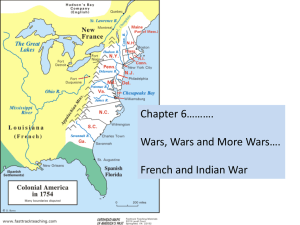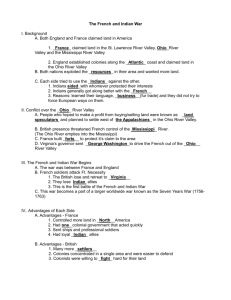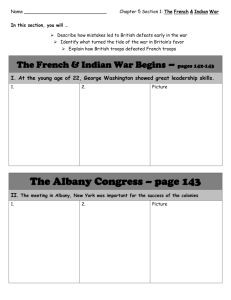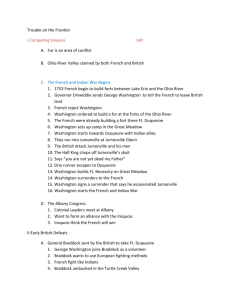French & Indian War
advertisement
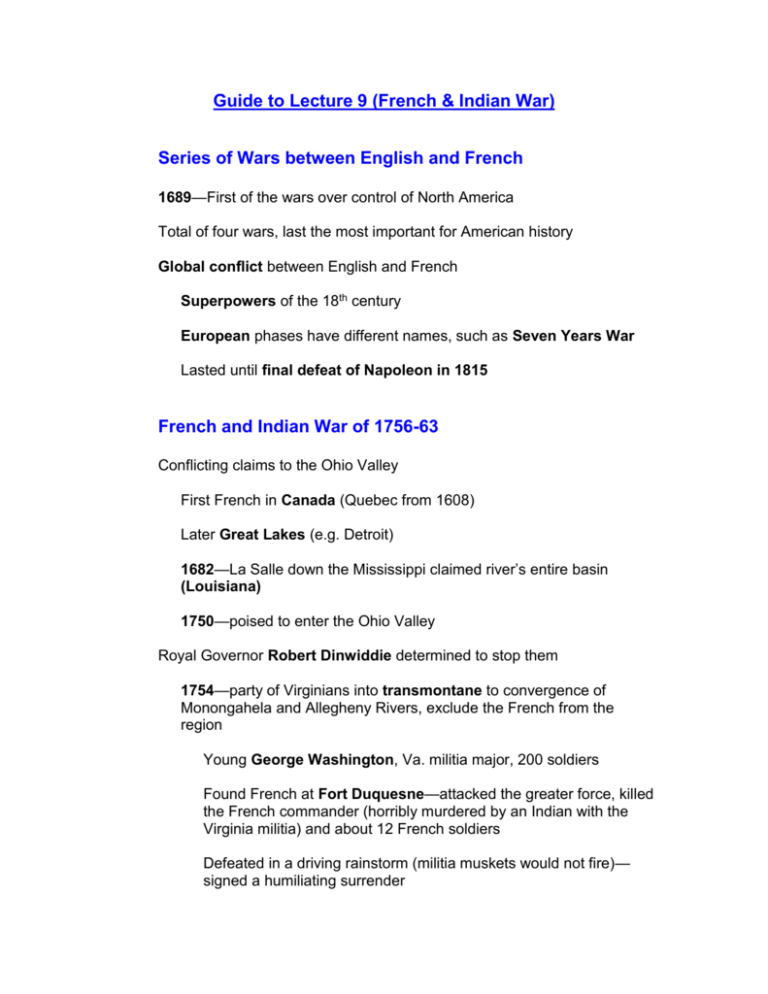
Guide to Lecture 9 (French & Indian War) Series of Wars between English and French 1689—First of the wars over control of North America Total of four wars, last the most important for American history Global conflict between English and French Superpowers of the 18th century European phases have different names, such as Seven Years War Lasted until final defeat of Napoleon in 1815 French and Indian War of 1756-63 Conflicting claims to the Ohio Valley First French in Canada (Quebec from 1608) Later Great Lakes (e.g. Detroit) 1682—La Salle down the Mississippi claimed river’s entire basin (Louisiana) 1750—poised to enter the Ohio Valley Royal Governor Robert Dinwiddie determined to stop them 1754—party of Virginians into transmontane to convergence of Monongahela and Allegheny Rivers, exclude the French from the region Young George Washington, Va. militia major, 200 soldiers Found French at Fort Duquesne—attacked the greater force, killed the French commander (horribly murdered by an Indian with the Virginia militia) and about 12 French soldiers Defeated in a driving rainstorm (militia muskets would not fire)— signed a humiliating surrender Brought about the French and Indian War British regulars, redcoats, now entered the picture General Edward Braddock with 2,500 to Duquesne Ambushed July 9, 1755—slaughtered—1,000 casualties to about 60 Braddock’s Defeat Different tactics needed to be used in frontier environment Straight battle lines—single-shot smooth bore muskets (50-100 yards) Bayonet to deliver the decisive blow to enemy Indian auxiliaries used by both sides, French more successfully Fur trade, cooperation by French English, land-hungry Iroquois (Mohawks, Seneca) pro-English, Huron proFrench Different cultural standards by Indians—torture and murder of captives Official declaration of war against France in May 1756. Involved almost every European nation England, Prussia against France, Austria, Russia, Sweden, Poland and Spain. Battles everywhere—North America, Europe, West Indies, Africa, India and Pacific. Started in Ohio Valley, was a true World War String of English defeats, but finally a victory in Acadia (Nova Scotia) in 1755. Acadians deported, some to New Orleans (Cajuns). William Pitt PM in 1756 Changed war strategy—emphasis overseas, not Europe Promised Parliament would pay the bill for American troops (huge war debt resulted). Began winning battles. 1758—Duquesne (Pittsburgh) 1759—Quebec. General James Wolfe and the heights of Abraham 1760—Montreal France losing on all fronts Importance of French and Indian War Treaty of Paris, 1763 French expelled from the North American mainland—Canada, all of Louisiana east of Mississippi. Spain—Louisiana west of Mississippi, including New Orleans Spain gave Florida to English in exchange for Cuba. Greatest outcome of the war: led directly to the American Revolution. Why? Colonial view of mother country changed—no longer need British for protection, ready for more relaxed relation with mother country Changed colonial view of themselves—cultural distinctiveness, selfconfidence—British could be defeated. British view the colonies differently—new lands to administer, huge war debt to be retired French are left embittered, eager for revenge—chance during the Revolution—1778 alliance with American rebels, bankrupted French— new taxes set off French Revolution Summary Fourth and last of French/English wars 1756-63, also Seven Years War Erupted over concerns with French claims in Ohio Valley—Canada, Great Lakes, Mississippi, now Ohio Valley Early defeats for British and young George Washington 1755--Braddock at Fort Duquesne Different tactics needed Indian auxiliaries used 1756—William Pitt changed English strategy—focus on America English victories—Acadia 1755, Quebec 1759, Montreal 1760 Treaty of Paris, 1763—French out of North American mainland, Spain— La. west of Mississippi, including New Orleans Greatest outcome—led directly to American Revolution Colonial view of England Colonial view of selves English view of colonies French embitterment

